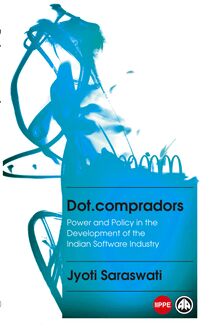-
 Univers
Univers
-
 Ebooks
Ebooks
-
 Livres audio
Livres audio
-
 Presse
Presse
-
 Podcasts
Podcasts
-
 BD
BD
-
 Documents
Documents
-
- Cours
- Révisions
- Ressources pédagogiques
- Sciences de l’éducation
- Manuels scolaires
- Langues
- Travaux de classe
- Annales de BEP
- Etudes supérieures
- Maternelle et primaire
- Fiches de lecture
- Orientation scolaire
- Méthodologie
- Corrigés de devoir
- Annales d’examens et concours
- Annales du bac
- Annales du brevet
- Rapports de stage
La lecture à portée de main
177 pages
English
Découvre YouScribe en t'inscrivant gratuitement
Je m'inscrisDécouvre YouScribe en t'inscrivant gratuitement
Je m'inscris
Obtenez un accès à la bibliothèque pour le consulter en ligne
En savoir plus
En savoir plus
177 pages
English
Obtenez un accès à la bibliothèque pour le consulter en ligne
En savoir plus
En savoir plus

Description
'India Shining' has become the brand name for a new India presented in Bollywood films, adverts and books. A key part of this image is the software industry, held up as the symbol of prosperity and post-modernity.
Dot.compradors reveals the darker reality behind 'India Shining', providing a history of the industry from the 1970s to the present. Jyoti Saraswati punctures the myth of a free-market industry by revealing the role of state intervention and how vested interests and elite corruption have shaped, and continue to shape, one of the world’s most dynamic sectors.
Saraswati argues that the interests attached to the software industry and the policies they are pursuing are both an impediment to the growth of local software firms and to a broader-based, more egalitarian form of development in India.
Preface
Acknowledgements
A Note on the Terminology
Glossary
List of Figures
A Primer: the Seven Leading Myths about the Indian IT Industry
1. Introduction
Part I: The Context
2. The Global Software Services Industry: An Overview
3. The Development of the Software Industry in India: Existing Explanations and their Shortcomings
4. The Political Economy of State Intervention and Industrial Transformation: An Analytical Framework
Part II: The Development of the Indian IT Industry
5. IT Started with a War
6. Catalytic Corruption: The Domestic Software Services Boom, 1978-1986
7. Manna from Heaven: Satellites, Optic Fibres and the Export Thrust, 1986-2000
8. Passage to India: The Giants in the Land of the Majors, 2000-2010
Part III: The Analysis
9. The Indian Mutiny: From Potential IT Superpower to Back Office of the World
10. Lessons from the Lies: What Does IT Mean?
11. Conclusion: Of Compradors and Useful Idiots
Notes
Appendices
Index
Dot.compradors reveals the darker reality behind 'India Shining', providing a history of the industry from the 1970s to the present. Jyoti Saraswati punctures the myth of a free-market industry by revealing the role of state intervention and how vested interests and elite corruption have shaped, and continue to shape, one of the world’s most dynamic sectors.
Saraswati argues that the interests attached to the software industry and the policies they are pursuing are both an impediment to the growth of local software firms and to a broader-based, more egalitarian form of development in India.
Preface
Acknowledgements
A Note on the Terminology
Glossary
List of Figures
A Primer: the Seven Leading Myths about the Indian IT Industry
1. Introduction
Part I: The Context
2. The Global Software Services Industry: An Overview
3. The Development of the Software Industry in India: Existing Explanations and their Shortcomings
4. The Political Economy of State Intervention and Industrial Transformation: An Analytical Framework
Part II: The Development of the Indian IT Industry
5. IT Started with a War
6. Catalytic Corruption: The Domestic Software Services Boom, 1978-1986
7. Manna from Heaven: Satellites, Optic Fibres and the Export Thrust, 1986-2000
8. Passage to India: The Giants in the Land of the Majors, 2000-2010
Part III: The Analysis
9. The Indian Mutiny: From Potential IT Superpower to Back Office of the World
10. Lessons from the Lies: What Does IT Mean?
11. Conclusion: Of Compradors and Useful Idiots
Notes
Appendices
Index
Sujets
Informations
| Publié par | Pluto Press |
| Date de parution | 06 juillet 2012 |
| Nombre de lectures | 0 |
| EAN13 | 9781849647342 |
| Langue | English |
| Poids de l'ouvrage | 2 Mo |
Informations légales : prix de location à la page 0,6250€. Cette information est donnée uniquement à titre indicatif conformément à la législation en vigueur.
Extrait
DOT.COMPRàdORS
Political Economy and Development
Published in association with the International Initiative for Promoting Political Economy (IIPPE)
Edited by Ben Fine (SOAS, University of London) Dimitris Milonakis (University of Crete)
Political economy and the theory of economic and social development have long been fellow travellers, sharing an interdisciplinary and multidimensional character. Over the last 50 years, mainstream economics has become totally formalistic, attaching itself to increasingly narrow methods and techniques at the expense of other approaches. Despite this narrowness, neoclassical economics has expanded its domain of application to other social sciences, but has shown itself incapable of addressing social phenomena and coming to terms with current developments in the world economy. With world financial crises no longer a distant memory, and neo liberalism and postmodernism in retreat, prospects for political economy have strengthened. It allows constructive liaison between the dismal and other social sciences and rich potential in charting and explaining combined and uneven development. The objective of this series is to support the revival and renewal of political economy, both in itself and in dialogue with other social sciences. Drawing on rich traditions, we invite contributions that constructively engage with heterodox economics, critically assess mainstream economics, address contemporary developments, and offer alternative policy prescriptions.
Also available:
The Political Economy of Development: The World Bank, Neoliberalism and Development Research Edited by Kate Bayliss, Ben Fine and Elisa Van Waeyenberge
Theories of Social Capital: Researchers Behaving Badly Ben Fine
Dot.compraDors
pOWeR ànd pOliCy in The DeVelOPMenT Of The Indiàn sOfTWàRe InduSTRy
Jyoti Saraswati
FiRST PubliShed 2012 by pluTO pReSS 345 aRChWày rOàd, LOndOn N6 5aa
WWW.PluTObOOkS.COM
DiSTRibuTed in The UniTed sTàTeS Of aMeRiCà exCluSiVely by pàlGRàVe màCMillàn, à diViSiOn Of sT màRTin’S pReSS LLc, 175 FifTh aVenue, NeW YORk, NY 10010
cOPyRiGhT © JyOTi sàRàSWàTi 2012
the RiGhT Of JyOTi sàRàSWàTi TO be idenTified àS The àuThOR Of ThiS WORk hàS been àSSeRTed by hiM in àCCORdànCe WiTh The cOPyRiGhT, DeSiGnS ànd pàTenTS aCT 1988.
BRiTiSh LibRàRy càTàlOGuinG in publiCàTiOn DàTà a CàTàlOGue ReCORd fOR ThiS bOOk iS àVàilàble fROM The BRiTiSh LibRàRy.
IsBN IsBN IsBN IsBN IsBN
978 0 7453 3266 6 978 0 7453 3265 9 978 1 8496 4734 2 978 1 8496 4736 6 978 1 8496 4735 9
HàRdbàCk pàPeRbàCk pDF eBOOk Kindle eBOOk EpUB eBOOk
LibRàRy Of cOnGReSS càTàlOGinG in publiCàTiOn DàTà àPPlied fOR
thiS bOOk iS PRinTed On PàPeR SuiTàble fOR ReCyClinG ànd Màde fROM fully MànàGed ànd SuSTàined fOReST SOuRCeS. LOGGinG, PulPinG ànd MànufàCTuRinG PROCeSSeS àRe exPeCTed TO COnfORM TO The enViROnMenTàl STàndàRdS Of The COunTRy Of ORiGin.
10
9
8
7
6
5
4
3
2
1
DeSiGned ànd PROduCed fOR pluTO pReSS by chàSe publiShinG seRViCeS LTd tyPeSeT fROM diSk by sTànfORd Dtp seRViCeS, NORThàMPTOn, EnGlànd siMulTàneOuSly PRinTed diGiTàlly by cpI anTOny rOWe, chiPPenhàM, UK ànd EdWàRdS BROS in The UniTed sTàTeS Of aMeRiCà
In memory of Professor S.K. Saraswati
Dot.comadj.of or relating to the information technology industry, particularly those aspects most closely associated with the internet and communications technologies.
Compradorn.a nativeborn agent employed by a foreign business to serve as a collaborator or intermediary in commercial transactions.
cOnTenTS
PrefaceAcknowledgementsA Note on the TerminologyGlossaryA Primer: The Seven Leading Myths about the Indian Software Industry
1Introduction 1.1 Background 1.2 Aims 1.3 Structure
PART 1 THE CONTEXT 2The Global Software Services Industry: An Overview 2.1 Introduction 2.2 Beneath the Tip of the IT Iceberg: The Size and Structure of the Hidden Industry 2.3 The Magnificent Seven: Introducing the Global Giants and the Indian Majors 2.4 Creative Destruction and the Development of the Industry, 1950–85 2.5 Convergence and Catchup in the Industry, 1985–2010 2.6 Conclusions 3The Development of the Software Industry in India: Existing Explanations and their Shortcomings 3.1 Introduction 3.2 Technological Advances 3.3 Intellectual Aptitude 3.4 Neoliberalism 3.5 The Developmental Department 3.6 Conclusions
xi xiv xvi xviii
xxiv
1 1 3 4
9 9
9
1
1
1
3
15 17
18 18 18 19 21 23 24
Viii Dot.compraDors
4The Political Economy Approach to State Intervention and Industrial Transformation: An Analytical Framework 27 4.1 Introduction 27 4.2 The Who and Why of Policy: The Interests Behind State Intervention 27 4.3 The Effect of Policy: A Structural Analysis 30 4.4 Conclusions 32
PART 2 THE DEVELOPMENT OF THE INDIAN IT INDUSTRY 5IT Started with a War: The Establishment of the Indian IT Industry, 1970–78 5.1 Introduction 5.2 The Wider Context: The State of Independence 5.3 Interests and Interventions: The Bombay IT Party 5.4 What Happened? Indian Computers and Software Exports 5.5 Conclusions 6Catalytic Corruption: The Domestic Software Services Boom, 1978–86 6.1 Introduction 6.2 The Wider Context: Back to Business – The Emergency and the Return of the Old Guard 6.3 Interests and Interventions: Illusions of Grandeur 6.4 What Happened? A Positive Case of Unintended Consequences 6.5 Conclusions 7Manna from Heaven: Satellites, Optic Fibres and the Export Thrust, 1986–2000 7.1 Introduction 7.2 The Wider Context: White Goods, Brown Sahibs – The Rise of India’s Consumer Society 7.3 Interests and Interventions: The American Dream 7.4 What Happened? The Emergence of the Majors 7.5 Conclusions 8Passage to India: The Giants in the Land of the Majors, 2000–10 8.1 Introduction 8.2 The Wider Context: Amongst the Believers – The Capitalist Conversion of India
35 35 35 39
43 47
4 4
9 9
49 51
55 57
59 59
59 61 63 65
67 67
6
7
coNtENtsix
8.3 Interests and Interventions: Software as Soft Power – The Rise of NASSCOM 70 8.4 What Happened? From Big Dream to Major Nightmare 72 8.5 Conclusions 75
PART 3 THE ANALYSIS 9The Indian Mutiny: From Potential IT Superpower to Back Office of the World 9.1 Introduction 9.2 In India but Not of India: The Software Industry in 2020 9.3 Poacher as Gamekeeper: Explaining the State’s Inaction 9.4 Never Mind the Buzzwords: A New Agenda 9.5 Conclusions 10Lessons and Warnings: What Does IT Mean? 10.1 Introduction 10.2 Don’t Believe the Hype: The Role of IT in Development 10.3 Beyond Good and Evil: The Role of the State in Development 10.4 Golden Calf or Trojan Horse? The Role of the Software Industry in the Indian Economy 11Conclusion: Of Compradors and Useful Idiots
NotesAppendicesA The Software Industry in India, by Type of Firm B IT Policy Formulation According to the Developmental Department Literature C The Internal Power Structure of NASSCOM D NASSCOM Executive Council, 2011–13 E NASSCOM and the Indian State Apparatus, 2010 F Priority Issues for Firms, NASSCOM and the State G Top Offshore Destinations for Software Services Index
79 79
7
9
82 83 86 87 87
8
9
7
1
93 95
99 131 131
132 133 134 135 136 137 138
-
 Univers
Univers
-
 Ebooks
Ebooks
-
 Livres audio
Livres audio
-
 Presse
Presse
-
 Podcasts
Podcasts
-
 BD
BD
-
 Documents
Documents
-
Jeunesse
-
Littérature
-
Ressources professionnelles
-
Santé et bien-être
-
Savoirs
-
Education
-
Loisirs et hobbies
-
Art, musique et cinéma
-
Actualité et débat de société
-
Jeunesse
-
Littérature
-
Ressources professionnelles
-
Santé et bien-être
-
Savoirs
-
Education
-
Loisirs et hobbies
-
Art, musique et cinéma
-
Actualité et débat de société
-
Actualités
-
Lifestyle
-
Presse jeunesse
-
Presse professionnelle
-
Pratique
-
Presse sportive
-
Presse internationale
-
Culture & Médias
-
Action et Aventures
-
Science-fiction et Fantasy
-
Société
-
Jeunesse
-
Littérature
-
Ressources professionnelles
-
Santé et bien-être
-
Savoirs
-
Education
-
Loisirs et hobbies
-
Art, musique et cinéma
-
Actualité et débat de société
- Cours
- Révisions
- Ressources pédagogiques
- Sciences de l’éducation
- Manuels scolaires
- Langues
- Travaux de classe
- Annales de BEP
- Etudes supérieures
- Maternelle et primaire
- Fiches de lecture
- Orientation scolaire
- Méthodologie
- Corrigés de devoir
- Annales d’examens et concours
- Annales du bac
- Annales du brevet
- Rapports de stage
Signaler un problème
YouScribe
Le catalogue
Le service
© 2010-2024 YouScribe















